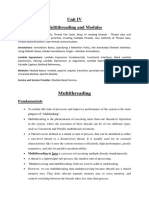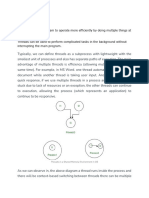0 ratings0% found this document useful (0 votes)
46 viewsMultithreading. Java
Multithreading in Java allows executing multiple threads simultaneously by using lightweight threads that share a common memory area. This saves memory compared to multiprocessing and has lower context switching costs. The main advantage of multithreading is that it allows performing multiple operations simultaneously without blocking the user. A thread can be in one of five states - new, runnable, running, non-runnable (blocked), and terminated. There are two ways to create threads in Java - by extending the Thread class or implementing the Runnable interface.
Uploaded by
Kaveri WakchaureCopyright
© © All Rights Reserved
We take content rights seriously. If you suspect this is your content, claim it here.
Available Formats
Download as PDF, TXT or read online on Scribd
0 ratings0% found this document useful (0 votes)
46 viewsMultithreading. Java
Multithreading in Java allows executing multiple threads simultaneously by using lightweight threads that share a common memory area. This saves memory compared to multiprocessing and has lower context switching costs. The main advantage of multithreading is that it allows performing multiple operations simultaneously without blocking the user. A thread can be in one of five states - new, runnable, running, non-runnable (blocked), and terminated. There are two ways to create threads in Java - by extending the Thread class or implementing the Runnable interface.
Uploaded by
Kaveri WakchaureCopyright
© © All Rights Reserved
We take content rights seriously. If you suspect this is your content, claim it here.
Available Formats
Download as PDF, TXT or read online on Scribd
You are on page 1/ 8
Multithreading
Multithreading in java is a process of executing multiple
threads simultaneously.
Thread is basically a lightweight sub-process, a small
unit of processing. Multiprocessing and multithreading,
both are used to achieve multitasking. But we use
multithreading than multiprocessing because threads
share a common memory area. They don't allocate
separate memory area so saves memory, and
context-switching between the threads takes less time
than process. Java Multithreading is mostly used in
games animation
Advantage of Java Multithreading:
1) It doesn't block the user because threads are independent and you can perform multiple
operations at same time.
2) You can perform many operations together so it saves time.
3) Threads are independent so it doesn't affect other threads if exception occurs in a single
thread.
Multitasking:
Multitasking is a process of executing multiple tasks simultaneously. We use multitasking to
utilize the CPU. Multitasking can be achieved by two ways:
Process-based Multitasking (Multiprocessing)
Thread-based Multitasking (Multithreading)
1) Process-based Multitasking (Multiprocessing)
Each process have its own address in memory i.e. each process allocates separate
memory area.
Process is heavyweight.
Cost of communication between the processes is high.
Switching from one process to another require some time for saving and loading
registers, memory maps, updating lists etc.
2) Thread-based Multitasking (Multithreading)
Threads share the same address space.
Thread is lightweight.
Cost of communication between the thread is low.
Life cycle of a Thread (Thread States):
A thread can be in one of the five states. But, there are only 4
states in thread life cycle in
java new, runnable, non-runnable and terminated. There is no
running state.
The life cycle of the thread in java is controlled by JVM. The
java thread states are as follows:
1. New
2. Runnable
3. Running
4. Non-Runnable (Blocked)
5. Terminated
1. New :
The thread is in new state if you create an instance of Thread class but before the
invocation of start() method. It remains in this state until the start() method is called on it
2. Runnable :
After a newly born thread is started, the thread becomes runnable. A thread in this state is
considered to be executing its task. But the thread scheduler has not selected it to be the
running thread.
3. Running:
Sometimes, a thread transitions to the waiting state while the thread waits for another
thread to perform a task. A thread transitions back to the runnable state only when
another thread signals the waiting thread to continue executing.
A runnable thread can enter the timed waiting state for a specified interval of time. A
thread in this state transitions back to the runnable state when that time interval expires
or when the event it is waiting for occurs.
The thread is in running state if the thread scheduler has selected it.
4. Non-Runnable (Blocked):
This is the state when the thread is still alive, but is currently not eligible to run.
5. Terminated :
A runnable thread enters the terminated state when it completes its task or otherwise
terminates.
Create thread:
There are two ways to create a thread:
1. By extending Thread class
2. By implementing Runnable interface.
Thread class:
Thread class provide constructors and methods to create and perform operations on a
thread. Thread class extends Object class and implements Runnable interface.
Commonly used Constructors of Thread class:
Thread()
Thread(String name)
Thread(Runnable r)
Thread(Runnable r, String name)
Thank You…
You might also like
- Java Multithreading Interview Questions And AnswersFrom EverandJava Multithreading Interview Questions And AnswersNo ratings yet
- Unit_3.1_MultiThreading.pptx_20250424_144710_0000No ratings yetUnit_3.1_MultiThreading.pptx_20250424_144710_000030 pages
- Unit - Iv Multithreading Multithreading in Java Is A Process of Executing Multiple Threads SimultaneouslyNo ratings yetUnit - Iv Multithreading Multithreading in Java Is A Process of Executing Multiple Threads Simultaneously43 pages
- Mastering Java: A Golden Collection of Questions & Answers for Success: Java: 200 Key Questions for a strong programming baseFrom EverandMastering Java: A Golden Collection of Questions & Answers for Success: Java: 200 Key Questions for a strong programming baseNo ratings yet
- Pájiña Aprovasaun Distribuisaun Sistema Informasaun Jeografia Hotel Iha Sidade Dili Bazeia Ba Web MonografiaNo ratings yetPájiña Aprovasaun Distribuisaun Sistema Informasaun Jeografia Hotel Iha Sidade Dili Bazeia Ba Web Monografia18 pages
- Mailvis: Visualizing Emailbox For Re-Finding EmailsNo ratings yetMailvis: Visualizing Emailbox For Re-Finding Emails2 pages
- A Collection of Red Team Focused Tools, Scripts, and NotesNo ratings yetA Collection of Red Team Focused Tools, Scripts, and Notes5 pages
- Installation: Websphere Voice Response For Aix With Directtalk TechnologyNo ratings yetInstallation: Websphere Voice Response For Aix With Directtalk Technology218 pages
- Get Access To The Comprehensive Teacher Email List Provided by The Education Data ListsNo ratings yetGet Access To The Comprehensive Teacher Email List Provided by The Education Data Lists2 pages
- Questions: Information Technology Question BankNo ratings yetQuestions: Information Technology Question Bank10 pages
- What Is The Difference of Phishing and Pharming?No ratings yetWhat Is The Difference of Phishing and Pharming?5 pages
- Installation and Configuration Guide for SAP Assurance and Compliance Software for SAP S4HANA_1.5SP00No ratings yetInstallation and Configuration Guide for SAP Assurance and Compliance Software for SAP S4HANA_1.5SP0078 pages
- Name-Shubhankar Kesari Id No - 19BAJMC024 Submitted To-Rishabh ChaudharyNo ratings yetName-Shubhankar Kesari Id No - 19BAJMC024 Submitted To-Rishabh Chaudhary5 pages
- Barangay Information Management System - Carsuche, Taal, BatangasNo ratings yetBarangay Information Management System - Carsuche, Taal, Batangas6 pages

























































































